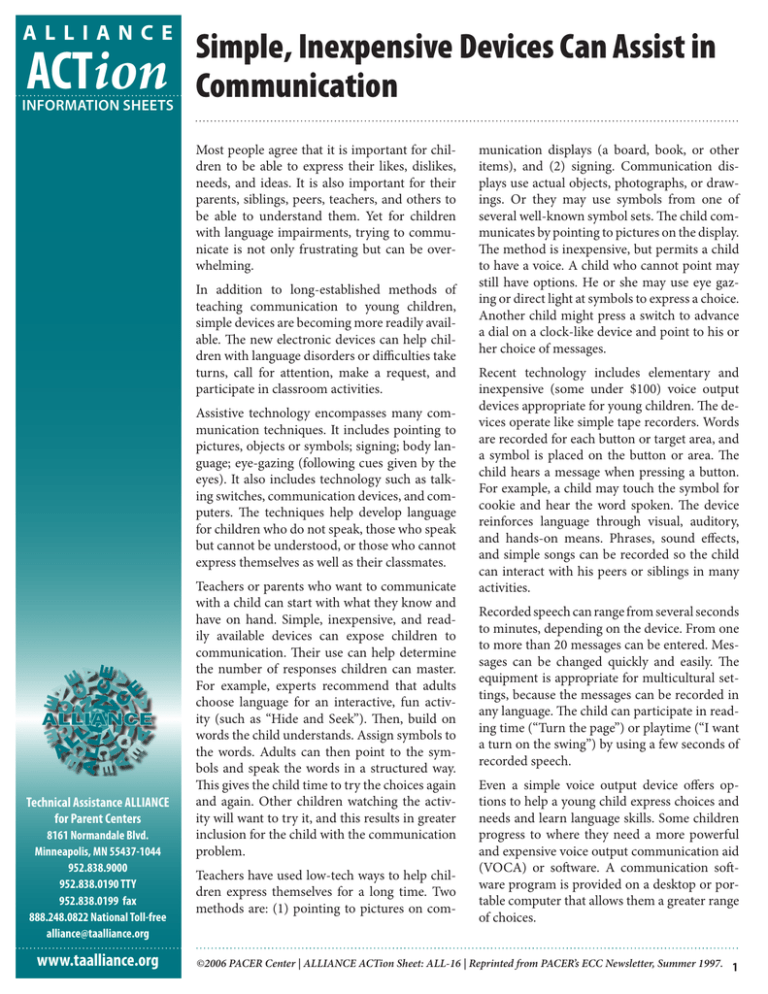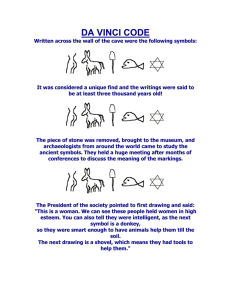Simple, Inexpensive Devices Can Assist in
advertisement

ALLIANCE ACTion INFORMATION SHEETS Simple, Inexpensive Devices Can Assist in Communication Most people agree that it is important for children to be able to express their likes, dislikes, needs, and ideas. It is also important for their parents, siblings, peers, teachers, and others to be able to understand them. Yet for children with language impairments, trying to communicate is not only frustrating but can be overwhelming. In addition to long-established methods of teaching communication to young children, simple devices are becoming more readily available. The new electronic devices can help children with language disorders or difficulties take turns, call for attention, make a request, and participate in classroom activities. Assistive technology encompasses many communication techniques. It includes pointing to pictures, objects or symbols; signing; body language; eye-gazing (following cues given by the eyes). It also includes technology such as talking switches, communication devices, and computers. The techniques help develop language for children who do not speak, those who speak but cannot be understood, or those who cannot express themselves as well as their classmates. Technical Assistance ALLIANCE for Parent Centers 8161 Normandale Blvd. Minneapolis, MN 55437-1044 952.838.9000 952.838.0190 TTY 952.838.0199 fax 888.248.0822 National Toll-free alliance@taalliance.org www.taalliance.org Teachers or parents who want to communicate with a child can start with what they know and have on hand. Simple, inexpensive, and readily available devices can expose children to communication. Their use can help determine the number of responses children can master. For example, experts recommend that adults choose language for an interactive, fun activity (such as “Hide and Seek”). Then, build on words the child understands. Assign symbols to the words. Adults can then point to the symbols and speak the words in a structured way. This gives the child time to try the choices again and again. Other children watching the activity will want to try it, and this results in greater inclusion for the child with the communication problem. Teachers have used low-tech ways to help children express themselves for a long time. Two methods are: (1) pointing to pictures on com- munication displays (a board, book, or other items), and (2) signing. Communication displays use actual objects, photographs, or drawings. Or they may use symbols from one of several well-known symbol sets. The child communicates by pointing to pictures on the display. The method is inexpensive, but permits a child to have a voice. A child who cannot point may still have options. He or she may use eye gazing or direct light at symbols to express a choice. Another child might press a switch to advance a dial on a clock-like device and point to his or her choice of messages. Recent technology includes elementary and inexpensive (some under $100) voice output devices appropriate for young children. The devices operate like simple tape recorders. Words are recorded for each button or target area, and a symbol is placed on the button or area. The child hears a message when pressing a button. For example, a child may touch the symbol for cookie and hear the word spoken. The device reinforces language through visual, auditory, and hands-on means. Phrases, sound effects, and simple songs can be recorded so the child can interact with his peers or siblings in many activities. Recorded speech can range from several seconds to minutes, depending on the device. From one to more than 20 messages can be entered. Messages can be changed quickly and easily. The equipment is appropriate for multicultural settings, because the messages can be recorded in any language. The child can participate in reading time (“Turn the page”) or playtime (“I want a turn on the swing”) by using a few seconds of recorded speech. Even a simple voice output device offers options to help a young child express choices and needs and learn language skills. Some children progress to where they need a more powerful and expensive voice output communication aid (VOCA) or software. A communication software program is provided on a desktop or portable computer that allows them a greater range of choices. ©2006 PACER Center | ALLIANCE ACTion Sheet: ALL-16 | Reprinted from PACER’s ECC Newsletter, Summer 1997. 1 Young children need a safe, encouraging place to learn, practice, and experiment with language. All forms of communication should be welcomed and encouraged. Teachers, service providers, and parents should work together to develop new ways to communicate with their children. They also need to evaluate the child’s needs, capabilities, interests, and experiences regularly. This will help them set goals to help the child’s communication progress. There are many benefits to helping a child to speak. Children who can communicate can make choices. They can express their preferences, and wishes. They can share their ideas from a very early age. This, in turn, gives others the opportunity to know them and better assist them. Behavior improves as the child becomes an active learner and social being. Being able to communicate increases both self-esteem and motivation. 2


